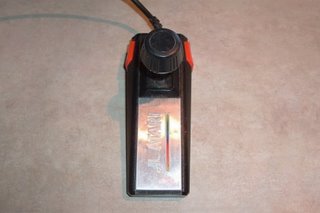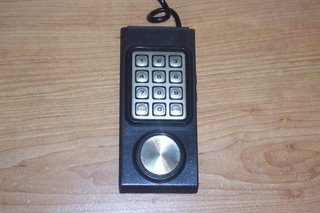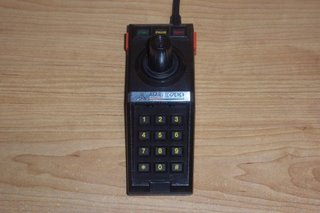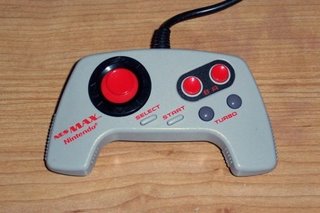
Intellivision interactive television. At least, that may have been the original concept idea behind the system.
They also designed the controller in a very untraditional way. It's more like a TV remote control of the time than a traditional game controller.
Aside from two buttons on each side of the controller, it also features a numeric keypad which is meant to allow a more advanced selection from the player. Each game also came with cards that can be inserted into the keypad, to display game-specific designations for the 12 keypad buttons.

The Odyssey 2 controller seems to be more or less inspired by the Atari 2600 controller. It looks similar, but in actual use it's quite different. The metal joystick moves differently and has more travel. More travel also means a slower response time.
To allow for more games, the Odyssey 2 also featured a keyboard right on the console. This allowed for personalised gameplay (name entry) and more complex input games.

After the Intellivision came out, Atari may have started getting worried and set out to create a system to counter it. The controller was basically designed to have everything A joystick, a keypad, 4 action buttons and it was the first controller to feature start, pause and reset buttons.
The trouble is, nobody actually liked the controller. The joystick, although similar looking to the Atari 2600 stick is analog, but is not self-centering. Also, in an effort to keep the controller compact, the internal for the analog joystick was designed with sliding "guides" that turn the analog on or off.

After the Atari 5200's lukewarm reception, Atari went back to the drawing board and tried again. The Atari 7800 was to take the best features of both the Atari 2600 and 5200 and also compete against both the ColecoVision and Intellivision.
Because most people found the Atari 5200 controller confusing and difficult to use, the Atari 7800 was designed to a much simpler controller, which consists of a digital joystick and action buttons on both sides. Some of this also revolves around the fact that the Atari 7800 could also play Atari 2600 games, which generally used just a basic joystick and one button.

Somehow, this controller from the 8-bit era has the evolutionary beginnings of features that would be found much later in the 32 and 64-bit era. It has the beginnings of the now familar handles, and very curiously, it also has a 360 degree thumb stick instead of the usual cross-shaped directional pad.
I'm not sure how much of an impact this controller had on subsequent generations because it wasn't as widespread as the regular NES controller. It may have been long forgotten by the time the 32/64-bit generation came along.
 Intellivision interactive television. At least, that may have been the original concept idea behind the system.
They also designed the controller in a very untraditional way. It's more like a TV remote control of the time than a traditional game controller.
Aside from two buttons on each side of the controller, it also features a numeric keypad which is meant to allow a more advanced selection from the player. Each game also came with cards that can be inserted into the keypad, to display game-specific designations for the 12 keypad buttons.
Intellivision interactive television. At least, that may have been the original concept idea behind the system.
They also designed the controller in a very untraditional way. It's more like a TV remote control of the time than a traditional game controller.
Aside from two buttons on each side of the controller, it also features a numeric keypad which is meant to allow a more advanced selection from the player. Each game also came with cards that can be inserted into the keypad, to display game-specific designations for the 12 keypad buttons.
 The Odyssey 2 controller seems to be more or less inspired by the Atari 2600 controller. It looks similar, but in actual use it's quite different. The metal joystick moves differently and has more travel. More travel also means a slower response time.
To allow for more games, the Odyssey 2 also featured a keyboard right on the console. This allowed for personalised gameplay (name entry) and more complex input games.
The Odyssey 2 controller seems to be more or less inspired by the Atari 2600 controller. It looks similar, but in actual use it's quite different. The metal joystick moves differently and has more travel. More travel also means a slower response time.
To allow for more games, the Odyssey 2 also featured a keyboard right on the console. This allowed for personalised gameplay (name entry) and more complex input games.
 After the Intellivision came out, Atari may have started getting worried and set out to create a system to counter it. The controller was basically designed to have everything A joystick, a keypad, 4 action buttons and it was the first controller to feature start, pause and reset buttons.
The trouble is, nobody actually liked the controller. The joystick, although similar looking to the Atari 2600 stick is analog, but is not self-centering. Also, in an effort to keep the controller compact, the internal for the analog joystick was designed with sliding "guides" that turn the analog on or off.
After the Intellivision came out, Atari may have started getting worried and set out to create a system to counter it. The controller was basically designed to have everything A joystick, a keypad, 4 action buttons and it was the first controller to feature start, pause and reset buttons.
The trouble is, nobody actually liked the controller. The joystick, although similar looking to the Atari 2600 stick is analog, but is not self-centering. Also, in an effort to keep the controller compact, the internal for the analog joystick was designed with sliding "guides" that turn the analog on or off.
 After the Atari 5200's lukewarm reception, Atari went back to the drawing board and tried again. The Atari 7800 was to take the best features of both the Atari 2600 and 5200 and also compete against both the ColecoVision and Intellivision.
Because most people found the Atari 5200 controller confusing and difficult to use, the Atari 7800 was designed to a much simpler controller, which consists of a digital joystick and action buttons on both sides. Some of this also revolves around the fact that the Atari 7800 could also play Atari 2600 games, which generally used just a basic joystick and one button.
After the Atari 5200's lukewarm reception, Atari went back to the drawing board and tried again. The Atari 7800 was to take the best features of both the Atari 2600 and 5200 and also compete against both the ColecoVision and Intellivision.
Because most people found the Atari 5200 controller confusing and difficult to use, the Atari 7800 was designed to a much simpler controller, which consists of a digital joystick and action buttons on both sides. Some of this also revolves around the fact that the Atari 7800 could also play Atari 2600 games, which generally used just a basic joystick and one button.
 Somehow, this controller from the 8-bit era has the evolutionary beginnings of features that would be found much later in the 32 and 64-bit era. It has the beginnings of the now familar handles, and very curiously, it also has a 360 degree thumb stick instead of the usual cross-shaped directional pad.
I'm not sure how much of an impact this controller had on subsequent generations because it wasn't as widespread as the regular NES controller. It may have been long forgotten by the time the 32/64-bit generation came along.
Somehow, this controller from the 8-bit era has the evolutionary beginnings of features that would be found much later in the 32 and 64-bit era. It has the beginnings of the now familar handles, and very curiously, it also has a 360 degree thumb stick instead of the usual cross-shaped directional pad.
I'm not sure how much of an impact this controller had on subsequent generations because it wasn't as widespread as the regular NES controller. It may have been long forgotten by the time the 32/64-bit generation came along.
0 Comments:
Post a Comment
<< Home